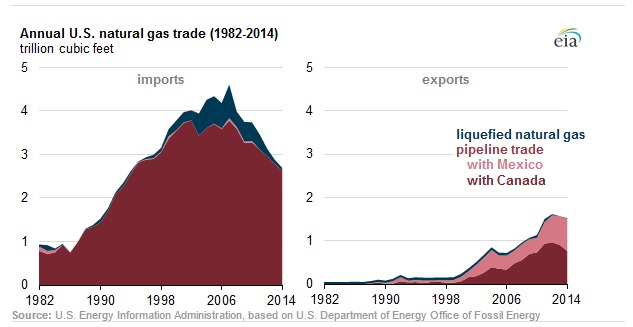Natural Gas Imports Hits Lowest Level in Decades
U.S. net imports of natural gas decreased 9% in 2014, continuing an eight-year decline. As U.S. dry natural gas production has reached record highs, lower domestic prices have helped to displace natural gas imports. Net natural gas imports (imports minus exports) totaled 1,171 billion cubic feet (Bcf) in 2014, the lowest level since 1987.
Imports by pipeline from Canada account for nearly 98% of all U.S. natural gas imports, and were the main driver of the decrease in total imports. Net imports from Canada represented 7% of total U.S. natural gas consumption in 2014, down from 11% in 2009.
 U.S. natural gas exports also decreased in 2014, but at a slower rate than the decrease in imports, and were still 9% above the previous five-year average. Natural gas exports to Mexico, which account for nearly 50% of U.S. natural gas exports, increased 12% in 2014.
U.S. natural gas exports also decreased in 2014, but at a slower rate than the decrease in imports, and were still 9% above the previous five-year average. Natural gas exports to Mexico, which account for nearly 50% of U.S. natural gas exports, increased 12% in 2014.
Net imports of liquefied natural gas (LNG) in 2014 totaled 43 Bcf, down 54% from the level in 2013 and continuing a five-year decline. LNG exports increased from 2013 levels, but not enough to offset a nearly 40% decrease in total LNG imports in 2014.
Net imports of natural gas have varied significantly around the country. New production from shale and other tight resources has helped to displace imports in certain regions. EIA's most recent analysis of natural gas imports and exports highlights regional trends in natural gas trade:
- Inflows of natural gas from Canada were equivalent to 50%-80% of New York’s natural gas consumption as late as 2008. In 2014, however, outflows of U.S.-produced natural gas through pipelines that crossed into Canada through New York state exceeded inflows of Canadian gas through pipelines into that state, as increased production from the Marcellus region outpaced regional demand.
- Pipeline outflows of natural gas crossing into Canada through Michigan and Minnesota exceeded inflows of natural gas, but inflows increased and outflows decreased in 2014, likely because of increased demand during the winter months of 2014.
- Natural gas exports to Mexico through pipelines crossing the international border in Texas, California, and Arizona increased to a record 706 Bcf in 2014 to meet increasing demand from new natural gas-fueled power plants in Mexico. Higher production of natural gas from the U.S. Gulf Coast and the Eagle Ford Shale in southern Texas contributed to the increase in exports to Mexico.
